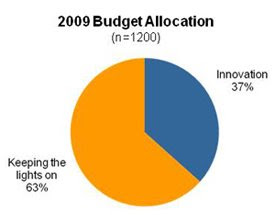Read a full transcript of the discussion.
As services pervade how and what IT delivers, quality assurance early and often becomes the gatekeeper of success -- or the points of failure.
IT's job is evolving to make sure all
 services really work deep inside of business process -- regardless of their origins and sourcing. Quality of component services is therefore assurance of quality processes, and so the foundation of general business conduct and productivity.
services really work deep inside of business process -- regardless of their origins and sourcing. Quality of component services is therefore assurance of quality processes, and so the foundation of general business conduct and productivity.Pervasive quality is no longer an option, especially as more uses of cloud-enabled services and so-called "fluid sourcing" approaches become the norm.
A large part of making quality endemic
 becomes organizational, of asserting quality in everything IT does, enforcing quality in everything IT's internal and external partners do. Success even now means quality in how the IT department itself is run and managed.
becomes organizational, of asserting quality in everything IT does, enforcing quality in everything IT's internal and external partners do. Success even now means quality in how the IT department itself is run and managed.To better learn how service-enabled testing and quality-enabling methods of running IT differently become critical mainstays of IT success, last week at HP Software Universe in Las Vegas I interviewed Robin Purohit, vice president of Software Products at HP Software and Solutions.
Here are some excerpts:
Severe restrictions on IT budgets force youRead a full transcript of the discussion.to rethink things. ... What are you really good at, and do you have the skills to do it? Where can you best leverage others outside, whether it’s for a particular service you want them to run for you or for help on doing a certain project for you? How do you make sure that you can do your job really well, and still support the needs of the business while you go and use those partners?
We believe flexible outsourcing is going to really take off, just like it did back in 2001, but this time you’ll have a variety of ways. We can procure those services over the wire on a rateable basis from whatever you want to call them -- cloud providers, software-as-a-service (SaaS) providers, whatever. IT's job will be to make sure all that stuff works inside the business process and services they’re responsible for.
If you think of it as marketplace of services that you're doing internally with maybe many outsource providers, making sure every one of those folks is doing their job well and that it comes together some way, means that you have to have quality in everything you do, quality in everything your partners do, and quality in the end process. Things like service-enabled testing, rather than service-oriented architecture (SOA), is going to become a critical mainstream attribute of quality assurance.
... What IT governance or cloud governance is going to be about is to make sure that you have a clear view of what your expectations are on both sides. Then, you have an automatic way of measuring it and tracking against it, so you can course correct or make a decision to either bring it back internally or go to another cloud provider. That’s going to be the great thing about the cloud paradigm -- you’ll have a choice of moving from one outsource provider to another.
The most important things to get right are the organizational dynamics. As you put in governance, you bring in outside parties -- maybe you’re doing things like cloud capabilities -- you're going to get resistance. You’ve got to train your team to how to embrace those things in the right way.
What we’re trying to do at HP is step up and bring advisory services to the table across everything that we do to help people think aboutIt’s all about allowing the CEO and their staffs to plan and strategize, construct and deliver, and operate services for the business in a co-ordinated fashion, and link all the decisions to business needs and checkpoints
how they should approach this in their organization, and where they can leverage potentially industry-best practices on the process side, to accelerate the ability for them to get the value out of some of these new initiatives that they are partaking in.
For the last 20 years, IT organizations have been building enterprise resource planning (ERP) systems and business intelligence (BI) systems that help you run the business. Now, wouldn’t it be great if there were a suite of software to run the business of IT?
It’s all about allowing the CEO and their staffs to plan and strategize, construct and deliver, and operate services for the business in a co-ordinated fashion, and link all the decisions to business needs and checkpoints. They make sure that what they do is actually what the business wanted them to do, and, by the way, that they are spending the right money on the right business priorities. We call that the service life cycle.
... There are things that we're doing with Accenture, for example, in helping on the strategy planning side, whether it’s for IT financial management or data-center transformation. We're doing things with VMware to provide the enabling glue for this data center of the future, where things are going to be very dynamically moving around to provide the best quality of service at the best cost.
... But, users want one plan. They don’t want seven plans. If there’s one thing they’re asking us to do more, faster, better, and with all of those ecosystem providers is to show them how they can get from their current state to that ideal future state, and do it in a coherent way.
There's no margin for error anymore.
Listen to the podcast. Download the podcast. Find it on iTunes/iPod and Podcast.com. Sponsor: Hewlett-Packard.










